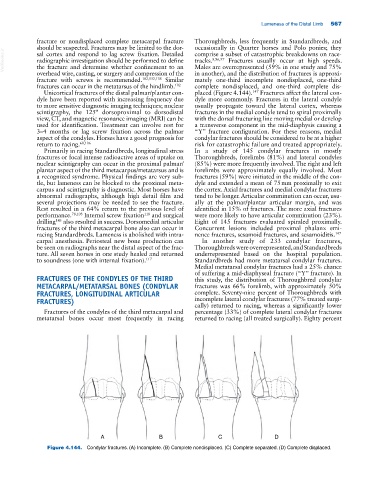Page 601 - Adams and Stashak's Lameness in Horses, 7th Edition
P. 601
Lameness of the Distal Limb 567
fracture or nondisplaced complete metacarpal fracture Thoroughbreds, less frequently in Standardbreds, and
should be suspected. Fractures may be limited to the dor- occasionally in Quarter horses and Polo ponies; they
VetBooks.ir radiographic investigation should be performed to define tracks. 8,96,97 Fractures usually occur at high speeds.
comprise a subset of catastrophic breakdowns on race-
sal cortex and respond to lag screw fixation. Detailed
Males are overrepresented (59% in one study and 75%
the fracture and determine whether confinement to an
overhead wire, casting, or surgery and compression of the in another), and the distribution of fractures is approxi-
fracture with screws is recommended. 102,132,138 Similar mately one‐third incomplete nondisplaced, one‐third
fractures can occur in the metatarsus of the hindlimb. 102 complete nondisplaced, and one‐third complete dis-
Unicortical fractures of the distal palmar/plantar con- placed (Figure 4.144). Fractures affect the lateral con-
147
dyle have been reported with increasing frequency due dyle more commonly. Fractures in the lateral condyle
to more sensitive diagnostic imaging techniques; nuclear usually propagate toward the lateral cortex, whereas
scintigraphy, the 125° dorsoproximal to dorsodistal fractures in the medial condyle tend to spiral proximally
view, CT, and magnetic resonance imaging (MRI) can be with the dorsal fracturing line moving medial or develop
used for identification. Treatment can involve rest for a transverse component in the mid‐diaphysis causing a
3–4 months or lag screw fixation across the palmar “Y” fracture configuration. For these reasons, medial
aspect of the condyles. Horses have a good prognosis for condylar fractures should be considered to be at a higher
return to racing. 68,106 risk for catastrophic failure and treated appropriately.
Primarily in racing Standardbreds, longitudinal stress In a study of 145 condylar fractures in mostly
fractures or focal intense radioactive areas of uptake on Thoroughbreds, forelimbs (81%) and lateral condyles
nuclear scintigraphy can occur in the proximal palmar/ (85%) were more frequently involved. The right and left
plantar aspect of the third metacarpus/metatarsus and is forelimbs were approximately equally involved. Most
a recognized syndrome. Physical findings are very sub- fractures (59%) were initiated in the middle of the con-
tle, but lameness can be blocked to the proximal meta- dyle and extended a mean of 75 mm proximally to exit
carpus and scintigraphy is diagnostic. Most horses have the cortex. Axial fractures and medial condylar fractures
abnormal radiographs, although high detail film and tend to be longer. Articular comminution can occur, usu-
several projections may be needed to see the fracture. ally at the palmar/plantar articular margin, and was
Rest resulted in a 64% return to the previous level of identified in 15% of fractures. The more axial fractures
118
performance. 78,103 Internal screw fixation and surgical were more likely to have articular comminution (23%).
drilling also resulted in success. Dorsomedial articular Eight of 145 fractures evaluated spiraled proximally.
145
fractures of the third metacarpal bone also can occur in Concurrent lesions included proximal phalanx emi-
racing Standardbreds. Lameness is abolished with intra- nence fractures, sesamoid fractures, and sesamoiditis. 147
carpal anesthesia. Periosteal new bone production can In another study of 233 condylar fractures,
be seen on radiographs near the distal aspect of the frac- Thoroughbreds were overrepresented, and Standardbreds
ture. All seven horses in one study healed and returned underrepresented based on the hospital population.
to soundness (one with internal fixation). 117 Standardbreds had more metatarsal condylar fractures.
Medial metatarsal condylar fractures had a 25% chance
of suffering a mid‐diaphyseal fracture (“Y” fracture). In
FRACTURES OF THE CONDYLES OF THE THIRD this study, the distribution of Thoroughbred condylar
METACARPAL/METATARSAL BONES (CONDYLAR fractures was 66% forelimb, with approximately 50%
FRACTURES, LONGITUDINAL ARTICULAR complete. Seventy‐nine percent of Thoroughbreds with
FRACTURES) incomplete lateral condylar fractures (77% treated surgi-
cally) returned to racing, whereas a significantly lower
Fractures of the condyles of the third metacarpal and percentage (33%) of complete lateral condylar fractures
metatarsal bones occur most frequently in racing returned to racing (all treated surgically). Eighty percent
A B C D
Figure 4.144. Condylar fractures. (A) Incomplete. (B) Complete nondisplaced. (C) Complete separated. (D) Complete displaced.

